The Long Haul, Part 2: What drives endurance drag racers?
In the first part of this series, we introduced you to a handful of the racers from this year’s Rocky Mountain Race Week (RMRW) 2.0. This kind of drag racing reads like the script of Two-Lane Blacktop, so we decided to dig into what makes this kind of automotive crazy break out of the restraints of common sense and normalcy. RMRW 2.0 entrants hit five tracks in five days. The 1300 miles accumulated between the tracks test a street car’s real-life manners as much as the races test its threshold performance. Sure, everyone has dreams of winning the $1000 best-in-class prize, or even the overall $15K pot, but these racers crawl across the U.S. in search of something more elusive and less quantifiable: a “good race.” What that means to each racer varies, as you’ll find.
Tom and Blayne Stark
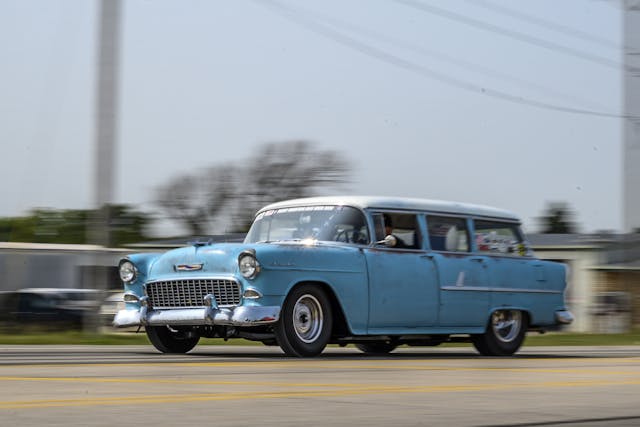
It’s not unusual for sons and daughters to ride along during Rocky Mountain Race Week, but few showed the precision of Tom and Blayne Stark, who are something of a local racing dynasty around Denver, Colorado. The codriver in enduro drags is an essential element, sharing the responsibility of navigating the transit stages and prepping the vehicle for each run. They also handle crucial start-line duties, like timing the burnout and lining the car up in the groove before the staging beams. This role requires a keen eye with experience and patience, skills that 12-year-old Blayne Stark displayed from day one.
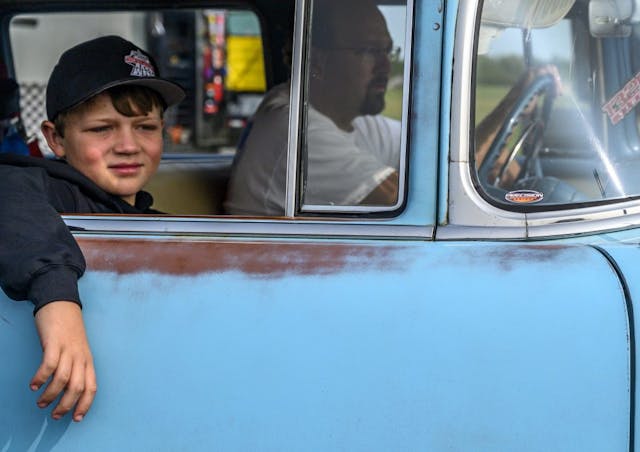
Tom Blayne has been drag racing since he was a boy; his father even “dabbled in Top Fuel” from the late ’50s through the early ’60s and worked with the NHRA for 15 years. Tom entered his son Blayne in Junior Dragsters for nearly five years, too, along with his older sister, MaCayla. Evidently, it runs in the family. “At eight years old, Blayne took apart the car I bought him,” says Tom, who was relegated to painting the chassis and body of Blayne’s Junior Dragster. Between working on Ridler-winning cars at his shop Precision Design Fabrications, Tom spends time racing with his wife and the kids. Tom and Blayne were first introduced to RMRW as it passed through Colorado’s Bandimere Raceway, where the pair happened to be racing a different event.
Together, the father and son hustle the family’s 1955 Chevrolet 210 wagon on RMRW. Less than a year ago, the long-roof was little more than a straight-six cruiser (with three-on-the-tree!) that dropped the kids off at school. “I’ve owned that car 15 years,” Tom says, “and we decided it needed to be freshened up because it was just wore out.” The Chevy fulfilled its kid-schlepping duties right up until January 1, 2020, when Blayne and Tom started dissecting it. “We jammed on it to get it ready for the Grand National Roadster Show at Pamona—I have a booth out there. We built the car in about two weeks, with Race Week being the end goal, and that’s why we did the car the way it’s done.”
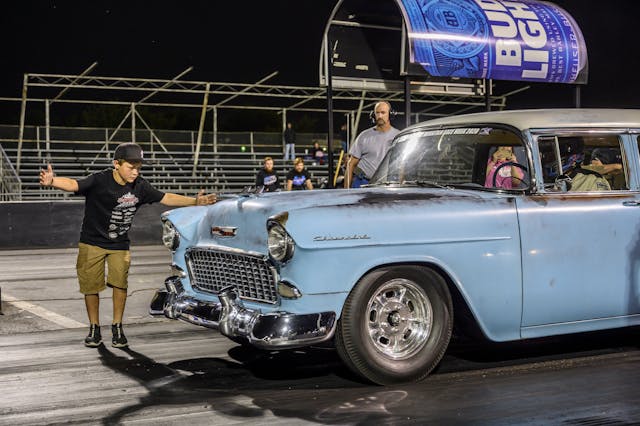

They began by pressure-washing every nook and cranny under the wagon. “Ow, that was the worst,” says Blayne. “So cold!” It was northern Colorado in January, after all. They also cleaned and stripped the frame for powder coating, “We spent six, seven hours washing under the car and scraping undercoat to get it presentable,” Tom says, but he left the body as original as possible to preserve its well-earned patina.
Once frame and body were reunited, the suspension got an overhaul. While the Tri-Five uses stock A-arms up front and the original leaf spring locations out back, everything else was replaced to update it for drag racing. QA1 shocks and Wilwood brakes sit at all four corners, and the rear leaf springs were replaced by Posies Super Slide springs supported by CalTrac bars. The rear end is a beefed-up Ford 9-inch by Mark Williams with a lightweight billet center section. The engine is a relatively low-buck affair: a 6.0-liter LS block with LS3 heads built around a 12:1 compression ratio and a shot of nitrous, with a Black Magic Nex-Gen lever clutch handling the chaos ahead of a TKO-600 transmission. “I’ve tried to take some Stock Eliminator and Super Stock knowledge and apply it to this,” Tom explains. “There’s a bunch of ET in the bell housing, if you’re willing to work for it.”
Work for it they have. Tom and Blayne entered Race Week 1.0 earlier this year before returning to the second event in early October. “I consider it like baseball, which is a very strategic game—you have to make very strategic moves. You have to have a plan going in, and it’s an endurance thing, so you can’t sprint the first leg. You’ve got to be smart with every run you make, and not just make runs to make runs,” Tom says. “And you gotta be willing to sacrifice a little to gain a lot.”
As the week went on, the Stark boys became more aggressive with the wagon, throwing a little more power at it each day as the miles between their front bumper and the last track on day five decreased. The wagon’s ET crept down from the mid-11s at the start of the week to an 11.084 on the final evening at Tulsa. While the times were nowhere near the top of the Hot Rod class at RMRW 2.0, the Chevy drew consistent attention as Blayne and Tom worked in a streamlined groove each run.
To the Starks, there’s a sharp contrast between those who thrive in endurance drag racing and those who sit on the sidelines. For Tom, “There’s not a lot of guys who have a hot rod that drives 1300 miles over five days, and there’s not a lot of guys who have race cars that run five days in a row. So when you put those two together, that is an amazing accomplishment.”
“I think it’s the ultimate test of is your car reliable enough, is it a street car or is it a race car?” Blayne says.
Royce Peyton

Some machines are born purely to kick against the skeptics. Endurance drag racing typically favors turbocharged drivetrains; the combo adds power but is gentle on the equipment it supports, and most teams have left behind traditional big-tire, big-blower cars. Not Royce Peyton, though. “We wanted to do it with a Roots-blown supercharger, and everybody told us we couldn’t,” says the owner of the all-steel 1965 Ford Mustang with a blown-alcohol tower of power out the hood. “So that was the determining factor in us making it happen.”
“We built this car around 2008 as a door-car that ran with other blown-alcohol cars in a class called B.A.D. Outlaws—Blown Alcohol Door cars,” he continued. The Mustang had hung around since Peyton’s high-school days, and it became his quarter-mile canvas through the years, ultimately growing into the mental street machine that it is now.
Roots-style blowers are one of the oldest horsepower-adding technologies out there. They’re beloved by most drag racers but lack the finesse of the turbos you’ll see in modern street cars. A blower car on the endurance drag racing scene is more strained, and transitioning from drag strip to highway requires more than simply dialing back the boost, like you would with a turbocharged powerplant. “We run a different supercharger on the street,” Peyton explains, “mostly because the race blower that we run has Teflon strips, and it can’t handle [continuous miles] on the street. We have a loose [tolerance] blower for the street.” They’ve also refined the cooling system and spent some serious time on the valvetrain—which was a real struggle, Peyton says, until horsepower whisperer Steve Morris came along. Morris drew up a custom-spec camshaft that refined the ramp speed of the valve opening and closing to help the 598-cubic-inch motor live with the street miles while still serving the big PSI High Helix 14-71 blower under power.
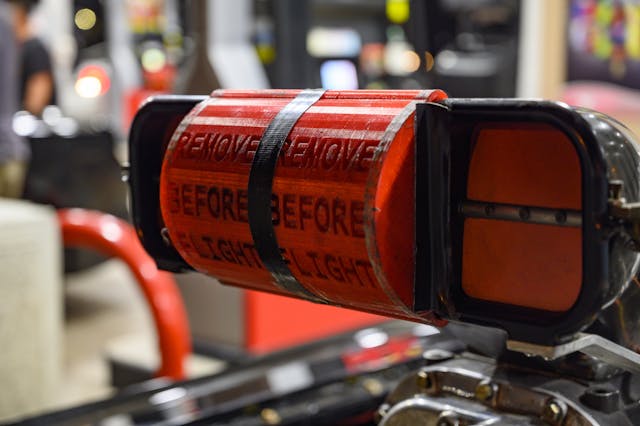
Fuel is supplied from one of two tanks: pump gas for the street in a 20-gallon tank and methanol in a separate 7-gallon one. A Neal Chance torque converter sends power through a three-speed Lenco gearbox thanks to a Bruno drive unit that replaces the Lenco’s typical foot clutch with a torque converter, a special combo for the enduro drag racing events. Though a Gear Vendors overdrive holds down the rpm on the freeway, Peyton is among the last of the street car crowd to use the Lenco’s old-school array of levers.
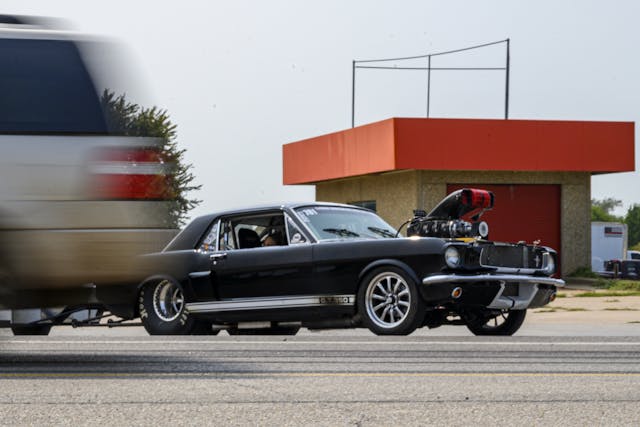
Peyton had the fight against mechanical attrition largely solved for Race Week 2.0 this year, but circumstances conspired against an overall win for the blown Mustang. On the first day, the car managed to spin the tire on the bead-locked wheel, which sheared the valve stem off the inner tube of the slick. Tom McGilton, who was also gunning for the overall victory, gave Peyton some spare valve stems and they were able to get it all remounted—but not before the tire tube “shook the car so bad I could not believe it,” Peyton says. “Imagine a five-pound tube wadded up on one side of your tire, throwing it off-balance.”
Another day, at Oklahoma’s Thunder Valley, ambient conditions at the track had just crossed the dew point when Peyton made his runs. The minuscule amount of moisture that settled on the track upset the Mustang’s assault on friction and resulted in a 8.325-second pass that pulled him away from the lead. Though the Mustang was still showing some of its strongest ETs ever, down in the 7.30s, but McGilton’s Camaro stayed just out of reach throughout RMRW 2.0. Peyton’s result would win the Unlimited Class and place him solidly in third overall.
Though he first entered Rocky Mountain Race Week years ago to help support Matt Frost, a life-long friend from his street-racing days in high school, RMRW has developed a more practical purpose. “It’s a great way to test the car a week straight at different tracks and different altitudes, and you can see what other people struggle with,” he says. “It really says something for the car—how badass it is if it can go the distance and still make 7-second passes. Our goal is to go faster every year.”
His best piece of advice?
“Build something that can finish the race, because if you don’t finish, it doesn’t really matter. We didn’t finish three times, and it sucked!”
Randall Reed and Aaron Shaffer

In most classes, you’re simply trying to win an all-out assault over five days. In others, however, you must balance your fastest passes against the technical certification of your car. RMRW’s 8.50-limited True Street class is a prime example. The rules here forbid funny-car cages, under the definition of what defines a true street car, so True Street entrants are limited by the 8.50-second certification of the acceptable cages. To succeed, they must finesse their machines as close to the 8.50-second time cap as possible; if they go too fast, they forfeit the run. It’s a game of minute adjustments, and victory can often measured in less than the blink of an eye—literally.
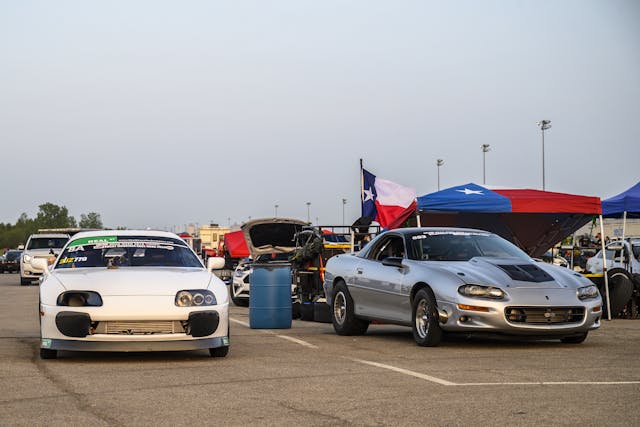
RMRW 2.0 was no different, and the in-house rivalry between the Anything Automotive-tuned showdown between Aaron Shaffer’s 1998 Chevy Camaro and Randall Reed’s 1993 Mustang LX Coupe proved it. Reed’s Mustang is an experienced competitor at Hot Rod Drag Week, making several tours through the Street Race Small-Block Power Adder, the parallel class to True Street, where finally won the hotly-contested class last year. Shaffer’s Camaro also made the rounds at Drag Week 2018, and both builds reflect the influence of Drag Weekers Jason Doisher and John Dodson from Anything Automotive.

Their reputations in the Denton, Texas area led Shaffer and Reed to Doisher and Dodson, and each commissioned nearly identical powerplants: an 88-mm Pro Mod turbo from Precision feeding an LS-based Dart 427-cu-in stacked with Trick Flow 245-cc heads and stuffed with a bumpstick from Brian Tooley Racing, with Holley EFI pulling the reigns. From there, Shaffer and Reed’s builds begin to differ. Reed’s lighter Mustang LX uses a simple two-speed Power Glide; Shaffer’s 500-pound-heavier Camaro relies on a three-speed TH400 setup.

“Injectors.” Reed’s early lead in True Street was set early with the help of an 8.502- and an 8.503-second pass by day three, but he noticed an issue in data logs and chose to swap injectors to remedy a potential lean-out problem. “The issue is that they were a bit bigger than what we had before,” he says. While he and co-driver/tuner Jason Doisher worked on the tune during the transit stage on the road to Great Bend, it delayed their ideal 8.50 trajectory just long enough for Shaffer to make up gap in the average ET late in the week. With John Dodson behind the keyboard on the tune-up, Shaffer’s Camaro was whittling down its average to that perfect 8.500, and an 8.515-second run from Reed would bring their averages together by Day Four.
“We were changing our launch boost by tenths of a PSI,” says Aaron. “If you were a few thousandths off, and you knew the car was consistent, then all you’d need to do is leave with a little more or a little less built up.” Ideally, a car will run the same ET and trap speed over and over if it leaves consistently—when you’re chasing a few thousandths of a second, the driver must make takes razor-thin adjustments to find the ideal number.
The final evening, all four players ran with precision: Shaffer and Dodson managing the Camaro and Doisher tweaking Reed’s Mustang back to its habit of 8.50- chops at the quarter-mile. They didn’t load into the staging lanes as soon as they opened; everyone waited until the density-altitude (the effective air density at a given altitude adjusted for the current temperature) fell into a range that promised the best conditions for the highest power. Once again, the game was down to finding the precise launch boost and exact rpm for each gear—while simultaneously trying to stay under the 8.50 tech limit. It was like playing blackjack with horsepower.
The Camaro emerged victorious. Shaffer managed to bring a repeat 8.500 time slip on the final night of racing, bringing a scant victory in True Street over Reed by a thousandth of a second: 8.511 to a 8.512. (For context, the human eye blinks in about 0.010 seconds.) Together, the two Texas-based teams nudged out the boys from Oklahoma: Jerome Courtney’s gunmetal-silver “Strickly Business” pickup trailed Shaffer and Reed by just a few hundredths of a second with an 8.54. Nothing short of perfection is required to take down this notoriously competitive class, even when the guy chasing you down is your friend. If not for Reed’s freak injector issue, who knows how narrowly the victory might have been split.
That’s a slice of what makes this masochistic test of vehicular and personal endurance so grand. Some drivers are chasing personal goals, and others are looking for the winner’s crowns, but everyone seeks to prove at least one thing: that they and their machine can survive another Race Week. If you want to check out more about what makes these Race Weekers tick, check out our coverage of this year’s 2.0 event.

